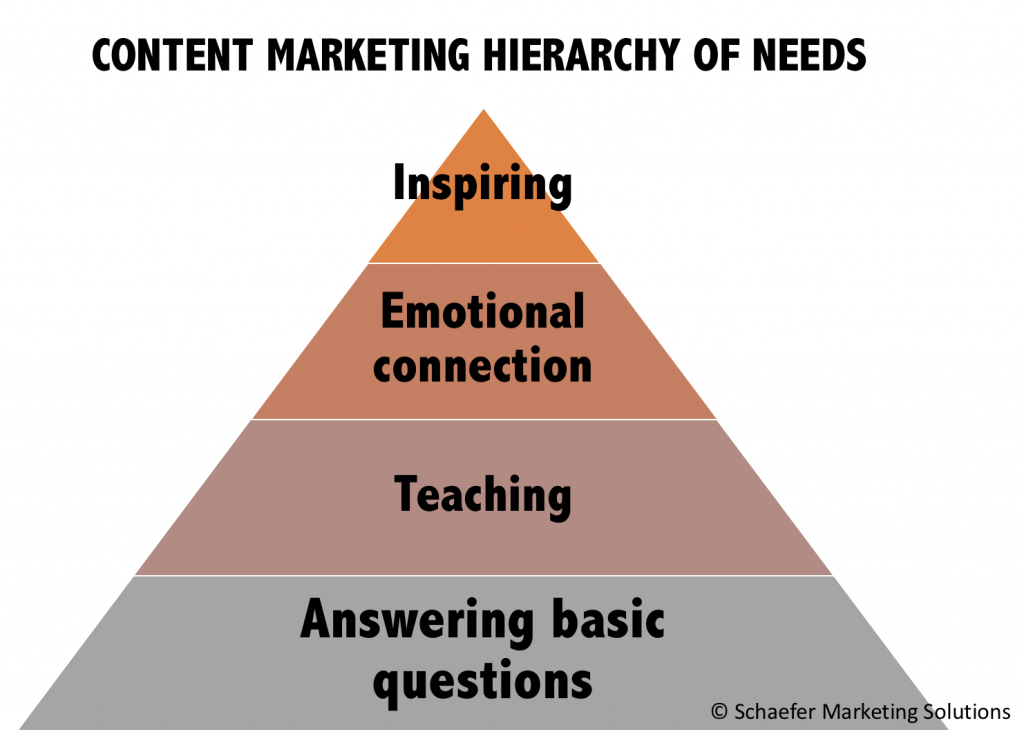The aspects of content marketing have been sliced and diced many ways but I think considering content in this “hierarchy of needs” format may help you simplify the process of determining a strategy for your business.
Of course there are many different kinds of content, and gratefully more are being invented all the time. But as I think about this, every kind of content I can think of ultimately serves one of four purposes. It is useful to think of content this way because the simple illustration has wide-ranging consequences for your business.
Let’s dig into this a little more today.
The content marketing hierarchy of needs
You’re probably familiar with the famous Maslow Hierarchy of Needs idea suggesting that humans must cover their basic needs (like food and shelter) before they can think about higher level goals like relationships and self-actualization. Likewise, content can serve a similar hierarchy of human needs.
1. ANSWERING QUESTIONS
The most simplistic form of content marketing is answering questions. If you are just starting out in content marketing and there is not yet much competition in your niche, this is the best place to start.
Answering basic questions is probably the easiest way to attract organic traffic to your website if there is not much existing competition. The problem with this type of content is that it may not attract repeat visits or earn much “time on site.” Once people get a question answered they will probably leave.
2. TEACHING
An excellent example of “teaching content” is the Social Media Examiner enterprise built by my friend Michael Stelzner. Each day, his SME posts are filled with helpful tips aimed at teaching the latest practices about social media. Another favorite of mine is Ancient History Encyclopedia that send me fascinating articles about ancient languages, the architecture of castles and the best way to make a sword.
This type of content can attract passionate fans, which provides opportunities for monetization through relevant programs and services (SME has a conference and member site; Ancient History has a magazine and sponsors trips).
3. EMOTIONAL CONNECTION
The real heart of marketing is finding a way to building an emotional connection between your business and your customer that leads to business benefits and perhaps even loyalty. The problem with the “teaching” articles I receive from SME or Ancient History is that I don’t really know the authors of the articles. The content is still a commodity and if I find something better I will immediately switch.
Emotional content connects to readers on a deeper level. You may love, admire, and even idolize a brand or personality through their video, photographs and blog posts. The biggest failure of marketing today is that it not building that emotional connection in a busy world. So this is an important type of content.
An article in The Wall Street Journal described how podcast stars are now selling out shows in theater tours! That sort of connection is long-lasting and powerful, isn’t it?
4. INSPIRATION
I have a quiz for you. What is the emotion most associated with content that goes viral?
Research from a number of sources indicates that word is “awe.”
This is epic content, content that is meant to inspire and entertain in a magnificent way. It may be a video of an inspirational speech or a movie-quality video from a global brand that makes you go “wow.”
Obviously this content is normally difficult and expensive to produce. It must be followed up with other marketing assets so the brand is not “one and done” based on one piece of content. Here is my favorite piece of hero content.
Implications for the Hierarchy of Content Marketing
How do you use these categories to think about content for your business? Here are some ideas:
- Cost — The cost of producing content generally goes up, from bottom to top.
- SEO — Supporting content with SEO may be more important at the bottom of the pyramid and less important at the top.
- Business goals — If you are trying to directly monetize content, that probably won’t work at the lower levels, for example.
- Differentiation — Are you in a crowded content niche? Consider opportunities to differentiate based on where competitors are on this hierarchy. If they are only answering questions, maybe move it up a level to stand out.
I’d like to hear your perspective on this idea. How does it relate to your business?




